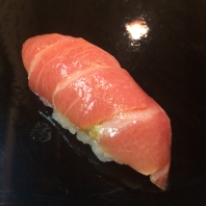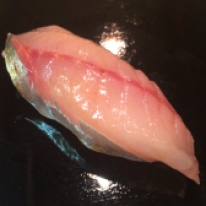Our last meal in Japan was at Sukiyabashi Jiro. It was over one month and three countries ago but the memory of a meal we’ve been lusting after ever since we saw Jiro Dreams of Sushi in 2011 isn’t one that fades easily from memory.

Jiro Ono, now 89, has been hailed by the Japanese government as a national treasure and is the oldest chef to have received three Michelin stars. If Jiro and his tiny, 10-person bar in the basement of Ginza station weren’t famous enough already, David Gelb’s epic documentary (which we rewatched before the trip), catapulted the sushi master into the international limelight, making Sukiyabashi Jiro a dream destination for sushi lovers all over the world. Since the meal, a lot of people have asked how it was; if it was the best meal of our lives, whether we met Jiro and, importantly, if it was worth the hype?? I’ll do my best to recount the experience here and tell you what I thought.
The Reservation
Sukiyabashi Jiro is notoriously difficult to land a table at. It consistently ranks towards the top of lists like “The 11 toughest reservations in the world” and “The world’s toughest restaurant reservations”. Getting in at Jiro’s is especially challenging if you’re a Gaijin, a foreigner or literally an “outsider” who doesn’t speak Japanese. Jiro accepts reservations only by phone and only on the 1st of the month prior. Spots fill up within hours and, if you’re one of the lucky ones to get through, you must speak Japanese and be prepared to provide some sort of backstop, e.g. a local company or hotel name. (Last minute cancellations by blasé foreigners have apparently made Jiro wary of Gaijin.)
The solution? Enlist the help of your Japanese friend or colleague or, in our case, your friendly hotel concierge. Get them to start calling early in the day and persist in the face of that pesky busy tone. Lunch is the same price as dinner (¥31,500 or US$260) and the menu is identical, so consider feasting earlier in the day. Finally, make sure you specify that you want to go to the original Ginza Sukiyabashi Jiro and not Jiro’s son Takashi’s branch in Roppongi, which is supposedly easier to get into.
The Lead Up
Armed with our lunchtime reservation, we headed toward Ginza at 1130am. There was no reason for us to leave so early (the ride from our hotel in Mistukoshimae to Ginza was a mere 5 minutes) but we’d checked out, stowed our luggage and succeeded in depriving ourselves of breakfast other than a small bite from Gontran’s.  We walked through Ginza station in a bit of a daze; I was giddy with excitement but also a little nervous. We’d finally be eating at Jiro’s! What would it be like? What would he be like? Would he be nice to us? What if he didn’t like us? (Jiro has attracted his fair share of infamy for being impatient with foreigners.) With all these questions and more swimming around in my head, I didn’t know whether to do a happy dance or frantically try and memorise more Japanese phrases. Watashi wa sebete o taberu. I eat everything.
We walked through Ginza station in a bit of a daze; I was giddy with excitement but also a little nervous. We’d finally be eating at Jiro’s! What would it be like? What would he be like? Would he be nice to us? What if he didn’t like us? (Jiro has attracted his fair share of infamy for being impatient with foreigners.) With all these questions and more swimming around in my head, I didn’t know whether to do a happy dance or frantically try and memorise more Japanese phrases. Watashi wa sebete o taberu. I eat everything. 
We killed some time browsing through the tiny boutiques in Ginza station until finally, it was time to walk through the nondescript glass doors in section B1. You could be forgiven for thinking this is a dead end, by the way. It’s all terribly corporate and uninspiring. There’s no signage and the doors open into a dull elevator bank. When you turn the corner, however, the silhouette of Jiro’s tiny restaurant is unmistakeable: it stands out like a zen oasis in an desert of concrete nondescriptness.
 A prominent sign at the door prohibits photographs and advises against walk-ins. Other than that, there’s nothing announcing your arrival at a sushi Mecca.
A prominent sign at the door prohibits photographs and advises against walk-ins. Other than that, there’s nothing announcing your arrival at a sushi Mecca.
We were met at the door by one of Jiro’s apprentices, who told us they were fully booked. We nodded “We have a reservation for 1230”. He pulled out a notepad and scanned it “Javeri?”. Once he’d confirmed who we were and the name of our hotel, he told us to come back in ten. I suppose we were a bit eager.
Fast forward and we were standing inside the cubby hole that separates the inner sanctum of Jiro’s world from Ginza station. The same apprentice took our coats and handed them to a a tiny old lady sitting at an even tinier desk, ushering us through.
Stepping into Sukiyabashi Jiro can only be described as surreal. It was as if we’d entered some sort of alternate universe: this warm, cosy little spot in the middle of a bustling station, it felt so strangely familiar. It looks exactly like it does in the movie. And standing behind the bar was Jiro Ono himself, flanked by his eldest son Yoshikazu and an apprentice. He wore a simple white smock and that familiar inscrutable expression that belies the passion he has for his craft.
We were led to one of three booths to sit and wait; another party had just finished their sushi and were sitting nearby, enjoying what appeared to be Jiro’s famous musk melon and green tea. We waited for all of 5 minutes before the apprentice reappeared and asked what we’d like to drink. Spying the 7D, he also said “no pictures please”. He told us it was fine to take pictures of the sushi though. Once Jiro was ready, we were led to the two seats at the end of the bar, giving us a headlong view of all the action. We were also now the only ones in the restaurant, sweet!
Jiro

Hot towels and a bottle of saké appeared promptly and we glanced down to see we each had a printed menu listing the day’s omakasé, with the names of the fish in English. Jiro’s apprentice reappeared, this time on the other side of the bar, and asked if we ate everything. I’d been rehearsing for this moment all morning but now that it had arrived, I blurted out a simple “Hai!”.
From here on out, it was the Jiro show. The 89 year old master shaped every piece of sushi himself. He stood in the centre of the tiny bar, Yoshikawa, his now 54 year old son, to his right; the same apprentice and defacto translator, to Yoshikawa’s right; the three of them forming one seriously talented assembly line. An assembly line so masterful, that it churned out piece after piece of perfect sushi, and in record time too. Jiro walked over to deliver each masterpiece to us himself. He’d deposit his creations onto our plates, always mine first, always with a little flourish. Then he’d walk back swiftly, resuming his position at the head of the assembly line and moving on to the next task.
We scooped up his masterpieces with reverence, foregoing the chopsticks, in favour of a firm, two-fingered grip. As I opened my mouth, ready to welcome the morsel about to hit my tongue and explode with flavour, I’d occasionally spot Jiro, stealing a glance in our direction, trying to ascertain our satisfaction. I did my best to appear floored, mesmerised, in heaven; it wasn’t hard. Jiro isn’t a tall man; standing side by side, I’ve got a couple of inches on him. Yet, behind that world-famous bar, he appears tall and lean. He moves with the dexterity and confidence of a much younger man, leaving little doubt as to who’s in charge.
Still, Jiro is not as brusque and stand-offish as some might make him out to be. At 20 odd minutes for 19 pieces of sushi, the meal is fast-paced for sure and, if you allow for the indulgence of a 1-2 photos per course, it can certainly feel rushed. However, Jiro at no point expressed the sort of impatience or hostility that reviewers like Andy Hayler have complained about. In fact, at one point, after using my chopsticks to pick up a sliver of ginger, I set them back down askance. Jiro immediately noticed and after depositing his latest creations onto our plates, picked up my delinquent chopsticks and returned them to their rightful place — parallel to the line of the table and resting on their ceramic holder rather than pointed toward the chef. I winced, vaguely aware that I’d broken some sort of cardinal chopstick rule and managed to offend this grand master. He picked up on my sheepishness and in a moment of hilarity, put his hands on his hips and glowered at me in mock anger before erupting into peals of laughter. Watching this 89 year old man clutch his stomach and rock with giggles was one of our favourite parts of the meal.
The Sushi
Here’s what we ate:
- Hirame (Fluke)

- Sumi- ika (Squid)
- Inada (Yellow tail)
- Akami (Tuna)
- Chu Toro (Semi Fatty Tuna)
- O Toro (Fatty Tuna)
- Kohada (Gizzard Shad)
- Tako (Octopus)
- Akagai (Arc-Shell Clam)
- Aji (Horse Mackerel)
- Hamaguri (Boiled Clam)
- Saba (Mackerel)
- Kuruma-ebi (Boiled Prawn)
- Sayori (Needle Fish)
- Uni (Sea Urchin)
- Kobashira (Baby Scallops)
- Ikura (Salmon Roe)
- Anago (Sea Eel)
- Tamago (Egg Custard)
- Musk Melon (served on table)
The hirame appeared promptly at 12.29. Pearlescent, perfectly shaped, bite-sized (Jiro gave me the “lady portions”), it was soft and luscious and lightly glazed with soy sauce. One of the first things that stood out was the rice; it was noticeably more vinegary and felt closer to room temperature. In any case, it paired beautifully with the hirame. Hirame, usually translates to English as “fluke” or “summer flounder” but was described on Jiro’s menu as “sole fish”; I figured it was a remnant from times when Jiro opened with Karei (winter flounder).

Next up was the sumi-ika or squid, which came out also at 12.29. I’ll be honest, I’ve never really enjoyed squid sushi, it’s often chewy and tough and a weird kind of sticky. All that changed in Japan though and after a few nice sushi meals, I was actually looking forward to Jiro’s squid. Jiro hadn’t embellished his squid with that trademark crisscross pattern, yet the flesh was tender and uncharacteristically unchewy with a clean bite.

Inada, a form of yellowtail appeared next, at 1230. “Yellowtail” is a bit of a misnomer or, at the very least, an umbrella term, as the taste of the fish varies quite a bit based on age and size. “Inada” is usually reserved for farmed yellowtail that is less than a year old and therefore still soft and fatty, like this piece.
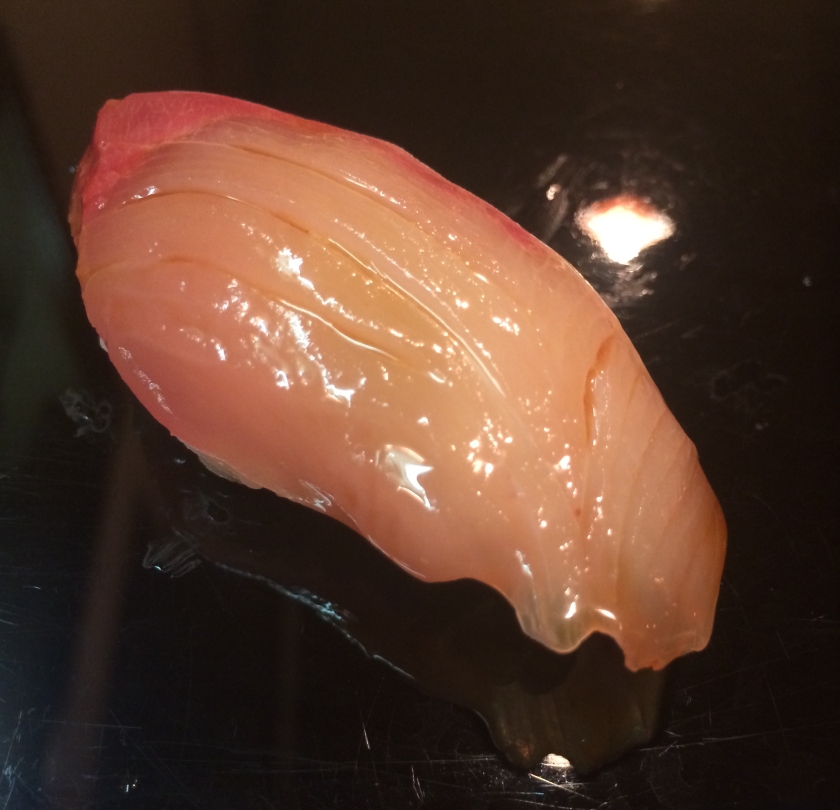
The next act was a trio of tuna. At 12.31 came the akami, followed by the chu-toro at 12.32 and and finally the oo-toro at 12.33. Each piece was uniquely delightful and the tro formed a beautiful crescendo in taste, texture and colour. The marbleised finalé of melt-in-the-mouth tuna belly paired perfectly with the vinegary rice and wasabi, and may have spoiled me for good.
At 12.34 came the kohada or Gizzard Shad, a fish that appears to be extremely popular in Japan and yet one I hadn’t encountered before the trip. Kohada is served with the skin intact, lending a strong fishy smell and taste to the nigiri. Normally I’d be a little turned off by the overwhelming fishiness of it all, but the skin also makes for a mesmerising display of colour that reminds me of the inside of a conch. Jiro’s light soy glaze added to the shine and I found myself staring at it a moment before popping it into my mouth.
 The kohada was followed by Jiro’s famous tako, or octopus at 12.35. As he presented the nigiri on my plate, I couldn’t help but think of the movie and of one his apprentices having to massage the poor octopus for 45 long minutes. Unlike the fish nigiri, which arrived with a glaze of soy sauce, Jiro’s tako was served with a simple dusting of salt.
The kohada was followed by Jiro’s famous tako, or octopus at 12.35. As he presented the nigiri on my plate, I couldn’t help but think of the movie and of one his apprentices having to massage the poor octopus for 45 long minutes. Unlike the fish nigiri, which arrived with a glaze of soy sauce, Jiro’s tako was served with a simple dusting of salt.
As with most nice sushi restaurants, at Sukiyabashi Jiro, you needn’t bother creating a soup of wasabi and soy sauce or worry about dipping your sushi in said soup without the rice falling apart. Jiro adds what he considers the appropriate amount of wasabi to every single piece of sushi; he then garnishes it with the appropriate glaze of soy sauce, sprinkle of salt or brush of nitsume. Each piece arrives on your plate ready to eat.
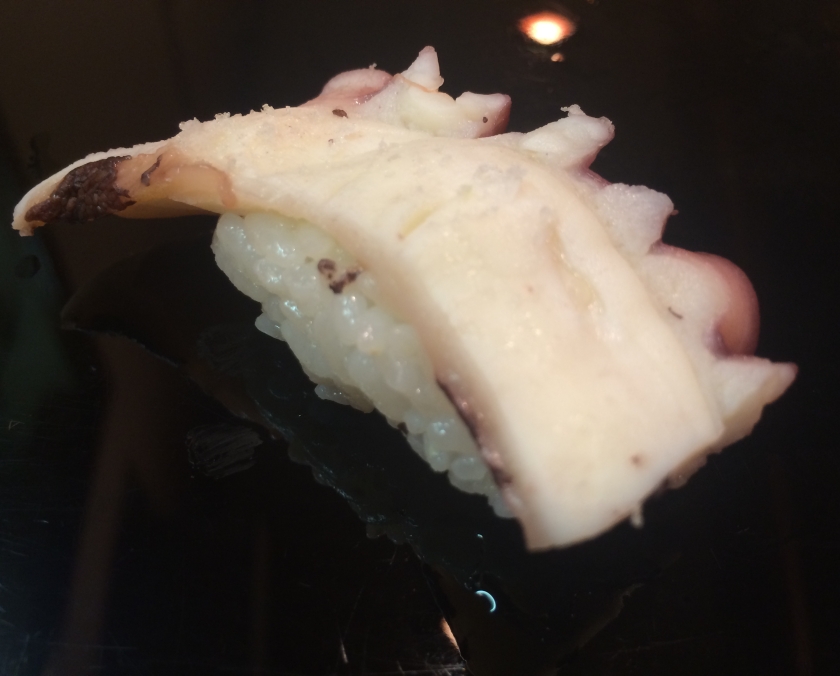
High on the heels of the tako, at 12.35 came the akagai. The arc-shell clam (or surf clam) is another specimen that’s less visible on omakasé menus outside of Japan. The akagai is beautifully presented, butterflied and gleaming with a visible dollop of wasabi that looks looks larger than I’d imagine was applied to previous courses. Of course the wasabi hits you with the very first bite, a slight distraction from the slightly chewy, rich flavour.

The theme of stronger flavours continued with the aji (horse mackerel) at 12.36 and the hamaguri (common hard shelled clam or Orient clam) at 12.38.
The aji was yet another beautiful specimen, slightly fishy, yet delicious. The hamaguri, on the other hand, looked like some sort of alien species; it was beautifully butterflied and glazed with a sweeter sauce.


The final act in the stronger flavoured series was the saba or mackerel, which appeared at 12.39. Mackerel spoils easily so it’s typically cured in salt for 3-4 hours and then washed with rice vinegar before filleting for sushi. Jiro serves his mackerel with a tiny sliver of skin and it’s perfectly tender with a hint of the ocean.

Finally at 12.40 came the kuruma-ebi (giant tiger prawn or Japanese imperial prawn) which, to my relief, was served in two pieces without the head and the “brains”. Fresh as can be, the prawn is boiled immediately after killing and then expertly sliced in a manner that is said to incorporate the taste of the head.

Now at this point, I have to note, I began to feel rather full. And this was despite eating at Jiro’s rapid pace (apparently it takes around 20 minutes for your stomach to signal that it’s full, hence why Jiro aims to conclude the meal in that timeframe). As spectacular as the ebi looked, I was reluctant to eat both pieces and would have preferred to eat it sans rice (it’s served without any sort of glaze, which makes it a little dry). I think Jiro’s apprentices must have picked up on my hesitation as he promptly appeared and asked if the portions were the right size for me (“we’ve been giving you the lady sizes, is that fine?”). I nodded appreciatively and smiled. I wondered if they’d give me even smaller portions now.
The sayori or needlefish, came out with a slight delay at 12.42 (yes, I just described 2 minutes as “a slight delay”). Needlefish, is another example of sushi that’s relatively uncommon outside Japan; it’s flavour leans towards the milder side and the cut itself was beautiful.

After the Sayori, began what I like to think of as the extended dessert course — a series of indulgent pieces characterised by rich textures, creamy flavours and balanced sweetness. First up was the uni (12.43) which Jiro presented atop the standard cylindrical tower of rice, encased with crisp seaweed. Interestingly, the end of the seaweed wrap was left unhinged, almost as a nod to careful carelessness. It made me all the more nervous about picking up the quivering pile of uni and fitting it into my mouth without mishap. The uni was, of course, delicious.

Next (12.44) was the kobashira (baby scallops): tender, silky and subtly flavourful. As with the uni, Jiro left the end of the seaweed deliberately untucked. Is this his trademark thing?

The third (12.45) in this trio of seaweed wrapped delicacies was the ikura (salmon roe). Ikura is another thing I usually pawn off to my companion diner (most often my husband). It’s not really my thing. Anyway, Jiro’s ikura was rich, fresh and kind of fun. I enjoyed the sensation of popping bubbles as I chomped down on this one.

And with that, it was time (12.47) for the last piece of fish: the sea eel. Anago has grown on me while in Japan and I was looking forward to its firmer, more meaty taste, glazed with sweet sauce for the finish. Jiro did not disappoint and though full, I happily devoured this as well.

And finally, the pièce de résistance, the tamago, arrived (12.48). I’d been looking forward to this all day and I was hopping in my seat when it arrived. I took a tiny bite and was not disappointed. It was firm but springy, delicately sweet and utterly un-egg like. It was also bigger than I’d expected and I nibbled on it for quite a while. Delicious!

Jiro’s apprentice returned to let us know we were done (we didn’t get an “are you full?” or “would you like more?”) and left us to sip on saké. A few minutes later, he reappeared on our side of the bar and asked if we’d like a picture with Jiro. Would we ever! We stepped outside and stood in front of the restaurant. Jiro’s apprentice took two photos with my iPhone 5S before Jiro instructed him in Japanese to rotate the phone and take a third. He was right, the third photo came out better than the first two, here it is below 🙂

After that interlude, we were guided back inside and seated at the same booth we’d initially waited at, except this time a thick slice of Jiro’s famous musk melon and some green tea awaited us. Musk melon is something of a delicacy in Japan; based on what I saw at Tokyo’s luxury department store food courts, a single melon can retail for close to US$100. Jiro’s apprentice also brought our saké over and we sipped hot and cold as we tucked into the incredibly juicy, melony goodness, with..a spork!
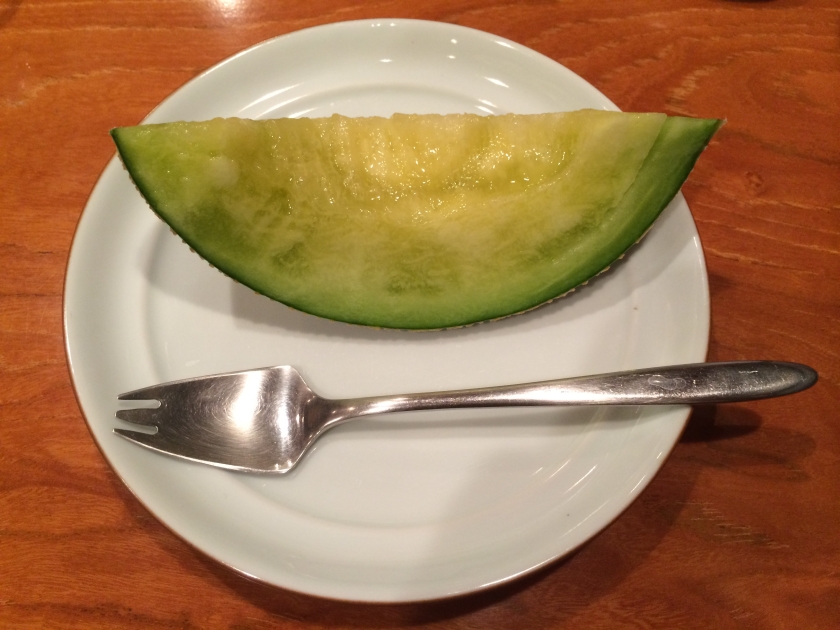
We lingered over this last part, so much so that Jiro’s next party arrived — a group of distinguished looking locals, a woman and two men. They must have been regulars because Jiro and Yoshikawa gave them a long bow along with some deferential words, which they returned before taking their seats at the centre of the bar. The last pour of our saké, the legendary Daiginjo Tokusei Gold, yielded a delicate gold leaf shaped like a cherry blossom. This was a beautiful touch on top of a saké that was already light, clean and refreshing. If you’re interested in trying it, not only does it retail for less than $10, but you can order it online right now. It’s also the only saké offered at Jiro’s.
Once we’d finished up, it was around 1.10pm. We settled the bill in cash (they do accept card now), were helped into our coats by Jiro’s apprentice and accompanied outside. As we walked away, we glanced backward to see the same apprentice standing outside, not in a low bow as Sawada had left us, but with his head low and his hands behind his back, respectful but reserved.
The Verdict
Eating at Jiro’s was a dream come true. Watching the 89 year old sushi master work his magic was riveting, knowing he was creating piece after piece of divine sushi solely for us was surreal. We were the only ones at the bar at 1230 and for that brief half hour, we had Jiro all to ourselves. (Jiro seems to prefer serving only one party at a time, something we noticed with the people before us and the ones right after.) So was it worth the hype? Well, if it’s any indication, I’d love to go back. The sushi really was spectacular and Jiro himself was incredible. The fact that this tiny man, who has been making sushi since he was 9 years old, is now approaching his 90s, and is still operating at his level is simply mind blowing. I think it’s worth eating at Sukiyabashi Jiro just to behold Jiro’s passion, persistence and commitment to perfection. I’d also like to return and enjoy the experience without worrying about photos or taking in every small detail. Sukiyabashi Jiro was not my favourite meal in Japan (that honour is reserved for Sushi Sawada) but it was, without a doubt, one of the most incredible dining experiences of my life.











